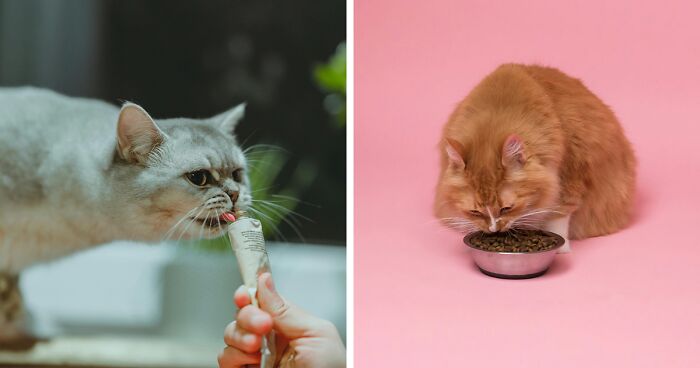Maintaining a cat’s digestive health is paramount for overall well-being. A well-planned transition is essential when switching cat foods, as abrupt dietary changes can disrupt their sensitive digestive systems.
This can lead to gastrointestinal upset, including vomiting and diarrhea, or even food aversion. Several factors like age or health issues can necessitate a switch in your cat’s food.
- Abrupt cat food changes can cause vomiting and diarrhea.
- Transitioning cat food over 7-10 days minimizes digestive upset.
- Consult a vet for cat's dietary needs due to health issues.
- Mixing old and new food helps cats adjust to dietary changes.
Let’s learn how to successfully transition your cat to a new food, minimizing digestive issues and promoting continued well-being.
The information provided herein is for informational purposes only. Please refer to our disclaimer for more details..
Reasons for Changing Your Cat’s Food
Sometimes, the best food for your cat changes over time. Here’s a breakdown of the most common reasons why you might need to shake up their menu:
- Age-related Changes: Think of it like this – you don’t eat the same food you did as a baby, do you? Our nutritional needs change as we age! Kittens need loads of energy-dense food for playful growth. Adult cats need a balanced diet for maintenance, while senior cats may benefit from formulas supporting joint health and easier digestion.
- Medical Conditions: Sometimes, just like us, our cats might develop health issues requiring a change in diet. Special diets can help manage allergies, kidney disease, digestive problems, and more. Your vet is your best resource here!
- Food Allergies or Intolerances: Ever had an upset tummy after eating something that didn’t agree with you? Cats can be the same way! Signs like vomiting, diarrhea, or itchy skin could mean a food allergy or intolerance. Switching to a diet with different ingredients can help.
- Palatability and Preference: Cats can be picky eaters, just like us! Maybe your cat seems bored with the same old food. Switching provides variety, spicing up their mealtime, and ensuring they get all the nutrients they need.
- Lifestyle Changes: Did your adventurous outdoor cat become more of a homebody? Or maybe your couch potato kitty got a burst of energy? Changes in activity levels can mean adjusting your cat’s food for optimal health.
- Food Discontinuation or Unavailability: Uh oh! Sometimes the perfect food for your cat becomes unavailable. Whether discontinued or hard to find, it’s time to find a suitable new option.
Choosing the Right New Cat Food
Think of this step as a treasure hunt for the perfect food for your feline companion!
- Seek Veterinary Advice: This is rule #1, especially if your cat has any health issues. Your vet knows your cat’s history and can offer the most tailored recommendations.
- Understanding Cat Food Labels: Pet food labels can be confusing! Learn to decipher them – look for high-quality protein as the primary ingredient, followed by essential nutrients your cat needs. Avoid too many fillers or additives.
- Types of Cat Food: Dry, wet, raw, prescription…the options are plentiful! Each has its pros and cons. Dry kibble is convenient, wet food boosts hydration, a vet might recommend a prescription diet for certain conditions. Consider your cat’s preferences and needs.
- Quality Over Price: Yes, some high-quality cat foods are pricier, but they often save you money in the long run! Nutritious food supports good health, potentially preventing vet visits later on.
- The Importance of AAFCO Standards: Look for cat food with an AAFCO nutritional adequacy statement. The Association of American Feed Control Officials (AAFCO) sets standards for pet food. A statement on the label means it has passed nutritional testing and is formulated for specific life stages or needs.
Switching cat food is an ongoing process. You might need to experiment with a few options to find your cat’s perfect match.
The Gradual Transition Process
You’ve got a shiny new bag of food, and your cat’s probably wondering what the fuss is all about. Now it’s time for the real trick – getting them onboard. Here’s how to make a smooth transition:
- The Importance of Slow and Steady: A sudden change in diet can wreak havoc on a cat’s digestive system, leading to vomiting, diarrhea, and your kitty giving you the side-eye for causing such tummy troubles. A gradual transition gives their gut bacteria time to adjust.
- Step-by-Step Guide: Here’s a vet-recommended timeline for mixing foods. This is usually done over 7-10 days, but may need adjustment based on your cat’s response:
- Days 1-2: 75% old food, 25% new food
- Days 3-4: 50% old food, 50% new food
- Days 5-7: 25% old food, 75% new food
- Days 8+: 100% new food (if your cat is tolerating it well)
- Kitten to Adult Food: This transition is important! Kitten food is too calorie-dense for adult cats. You’ll still want to do a gradual transition over a week or so, as the formulas differ.
- Wet to Dry (or vice versa): If switching food types, go even slower! Cats can be sensitive to texture changes. Start with a tiny amount mixed in and increase very gradually over about two weeks.
- Consistency is Comforting: Try to keep your cat’s mealtime routines as consistent as possible during the switch. Same times, same place – familiarity helps them feel secure, even when their food is changing.
- Adjusting as Needed: These are guidelines! If your cat seems to adapt quickly, you might slightly speed things up. But if they get an upset tummy, slow it down! It’s best to go at their pace.
- Monitoring for Issues: Watch for vomiting, diarrhea, decreased appetite, or lethargy. These could be signs the new food isn’t agreeing with them. If you see any concerning symptoms, contact your vet for advice.
Even with the best plan, some cats may still have mild digestive changes. This is usually temporary as their guts adjust.
Challenges in Transition Your Cat to A New Food
Even the best-laid plans sometimes hit snags when switching cat food. Here’s how to handle common challenges:
- Refusal to Eat: Some cats get stubborn as a rock! If your cat turns up their nose at the new food mixture, don’t give up entirely. Go back to the previous stage’s food ratio for a few days and try again with an even slower increase of the new food.
- Digestive Upset: Mild diarrhea or slight tummy grumbles are sometimes unavoidable. If it persists beyond a couple of days, or if they have severe vomiting, consult your vet. You may need to slow down the transition even more or try a different food altogether.
- Pacing the Transition: There’s no one-size-fits-all timeline! Some cats may breeze through in a week, others can take a month or longer. Monitor your cat closely and adjust the pace based on how they respond to the change.
Strategies for Picky Eaters
Cats can be creatures of habit, especially regarding food! Here are some tricks to tempt those picky palates:
- The Power of Wet Food: Most cats find wet food irresistible. Add a little to their usual dry food to introduce the flavor or texture of the new diet.
- A Touch of Warmth: Slightly warming wet food enhances its aroma, making it more enticing. Think of it like the kitty version of heating up delicious leftovers!
- Topping Temptations: Sprinkle a tiny amount of their favorite treat or a bit of the old food on top to encourage them to explore the new flavors.
- Option Overload: If they seem uninterested initially, try putting out both the old and new food in separate bowls, letting them choose their adventure.
Patience is key! Some cats simply need more time to adjust to change. Keep trying, and don’t hesitate to ask your veterinarian for additional tips or solutions tailored to your cat’s specific personality.
When to Consult a Veterinarian
While a gradual transition minimizes issues for most cats, sometimes a vet’s expertise is necessary:
- Before Switching for Health Reasons: If your cat has allergies, chronic diseases, or any medical condition, consulting your vet is essential. They’ll guide you on the best diet to manage their needs.
- Persistent Digestive Issues: Mild, temporary digestive upset is common during a switch. However, if your cat has severe vomiting, diarrhea that doesn’t improve after a few days, or becomes constipated, contact your vet.
- Significant Appetite Changes: A slight decrease in appetite might mean your cat is adjusting, but complete refusal of food or a sudden, insatiable appetite needs a vet’s assessment.
- Behavioral Changes: Lethargy, marked irritability, or unusual hiding behaviors along with other symptoms could signify an underlying issue or a severe reaction to the food change. Your vet can help determine the cause.
- Any Time You’re Concerned: You know your cat best! If something seems off or you have any questions, don’t hesitate to reach out to your veterinarian for advice.
Remember: Your veterinarian is your partner in your cat’s health! They can help ensure a smooth transition and address any concerns that arise.
Conclusion: How to Switch Cat Food
A well-managed food switch supports your cat’s health and happiness. It prevents digestive upset, encourages acceptance of the new food, and promotes overall well-being.
Your veterinarian is an invaluable resource for personalized food recommendations and guidance during the transition.
Remember, patience and observation are crucial. Every cat adjusts at their own pace, so monitor closely and enjoy watching them thrive on their new diet!
206views
Share on Facebook
 Dark Mode
Dark Mode 

 No fees, cancel anytime
No fees, cancel anytime 







 Image credits:
Image credits:  Image credits:
Image credits:  Image credits:
Image credits:  Image credits:
Image credits: 










































-3
0